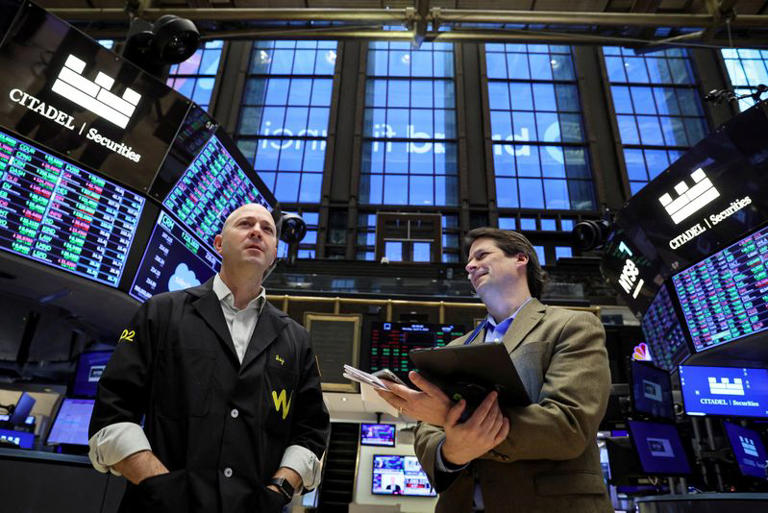As the new trading week begins, U.S. stock futures are showing mixed signals. Investors are keenly watching for a crucial employment report due later this week, which could significantly influence Federal Reserve policymakers’ decisions on potential interest rate cuts this year. Meanwhile, Nvidia (NASDAQ:NVDA) has unveiled the latest generation of its critical artificial intelligence chip, a strategic move aimed at staying ahead of rising competition.
U.S. stock futures presented a mixed trend as the trading week commenced, reflecting the market’s anticipation and uncertainty. This comes after a strong performance in May, where all three major indices on Wall Street posted significant gains. Early morning trading saw the Dow futures dipping by 32 points or 0.1%, while S&P 500 futures edged up by 10 points or 0.2%, and Nasdaq 100 futures climbed by 79 points or 0.4%.
The previous month’s trading closed on a positive note for the Dow Jones Industrial Average and the benchmark S&P 500, while the tech-heavy Nasdaq Composite saw a slight decline. Over May, the Dow increased by 2.4%, the S&P 500 rose by 4.8%, and the Nasdaq advanced by 6.9%. Last Friday, traders were digesting mixed economic data that indicated persistent inflationary pressures alongside weakening consumer spending. This has led investors to assign roughly even odds to the possibility of a Federal Reserve interest rate cut in September, with another potential reduction eyed for December.
A highly anticipated nonfarm payrolls report, due this Friday, is expected to provide further insights into the U.S. labor market’s resilience amid elevated interest rates. Economists forecast the addition of 185,000 jobs in May, a slight increase from April. Concerns have emerged that a robust economy might deter the Fed from lowering rates or even necessitate a rate hike. However, data last month showing a slowdown in inflation and a cooling job market temporarily alleviated these worries. Policymakers have maintained a cautious stance, calling for more evidence that inflation is trending sustainably towards the Fed’s 2% target. Minneapolis Fed President Neel Kashkari recently echoed this sentiment, suggesting that rates might need to stay on hold for an extended period.
A weaker employment report could signal an easing in the broader economy, potentially reducing inflationary pressures and supporting the case for rate cuts. Investors are particularly focused on this data, as it could provide critical signals for the Fed’s future policy direction.
Nvidia, a key player in the semiconductor industry, has announced its latest line of AI-optimized chips. This move is seen as an effort to maintain its market leadership amid growing competition. In a surprising weekend announcement, Nvidia revealed its new chip architecture, dubbed “Rubin,” set to ship in 2026. This announcement comes even before the rollout of its next generation of data center processors, “Blackwell,” which itself follows closely on the heels of the current “Hopper” chips.
Nvidia, which has seen its market value soar by around $350 billion after reporting stellar revenue figures, is striving to stay ahead of rivals such as Advanced Micro Devices (NASDAQ:AMD) and Intel (NASDAQ:INTC), as well as tech giants like Google-owner Alphabet (NASDAQ:GOOGL) and Microsoft (NASDAQ:MSFT), which are developing their own in-house chips. In a parallel move, AMD unveiled an update to its flagship AI chip, the MI325X accelerator, and announced a new series of MI350 processors set for release in 2025.
China’s manufacturing sector showed signs of growth in May, as indicated by the private Caixin manufacturing PMI, which came in at 51.7, slightly above expectations and higher than the previous month’s 51.4. This contrasted with the official PMI reading from Friday, which showed an unexpected contraction in manufacturing activity. The Caixin PMI focuses on smaller, private businesses primarily in southern China, whereas the official survey targets larger, state-run enterprises in the north. Investors typically consider both surveys to gain a comprehensive view of the Chinese economy.
Oil prices saw a slight increase in European trading after OPEC+ decided to extend its current production cuts into next year, a widely expected move. Brent oil futures rose to $81.21 a barrel, while West Texas Intermediate crude edged up to $76.82 per barrel. OPEC+ announced the continuation of output cuts totaling about 5.86 million barrels per day into 2025. This includes maintaining 3.6 million bpd of cuts until the end of 2025, with an additional 2.2 million bpd reduction extended until the end of September 2023. These will then be gradually phased out from October 2023 to September 2025. Concerns about sustained high interest rates potentially dampening demand in the U.S., the world’s largest oil consumer, had contributed to a decline in oil prices last week.
Overall, these developments paint a dynamic picture of the market, influenced by significant economic data, corporate strategies, and geopolitical factors. Investors will be closely monitoring these events as they unfold throughout the week, seeking to navigate the complexities of the current economic landscape.
